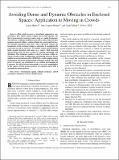Avoiding Dense and Dynamic Obstacles in Enclosed Spaces: Application to Moving in Crowds
Author(s)
Huber, Lukas; Slotine, Jean-Jacques; Billard, Aude
DownloadPublished version (7.010Mb)
Publisher with Creative Commons License
Publisher with Creative Commons License
Creative Commons Attribution
Terms of use
Metadata
Show full item recordAbstract
This article presents a closed-form approach to constraining a flow within a given volume and around objects. The flow is guaranteed to converge and to stop at a single fixed point. The obstacle avoidance problem is inverted to enforce that the flow remains enclosed within a volume defined by a polygonal surface. We formally guarantee that such a flow will never contact the boundaries of the enclosing volume or obstacles. It asymptotically converges toward an attractor. We further create smooth motion fields around obstacles with edges (e.g., tables). Both obstacles and enclosures may be time-varying, i.e., moving, expanding, and shrinking. The technique enables a robot to navigate within enclosed corridors while avoiding static and moving obstacles. It was applied on an autonomous robot (QOLO) in a static complex indoor environment and tested in simulations with dense crowds. The final proof of concept was performed in an outdoor environment in Lausanne. The QOLO-robot successfully traversed a marketplace in the center of town in the presence of a diverse crowd with a nonuniform motion pattern.
Date issued
2022-10Department
Massachusetts Institute of Technology. Nonlinear Systems LaboratoryJournal
IEEE Transactions on Robotics
Publisher
Institute of Electrical and Electronics Engineers
Citation
L. Huber, J. -J. Slotine and A. Billard, "Avoiding Dense and Dynamic Obstacles in Enclosed Spaces: Application to Moving in Crowds," in IEEE Transactions on Robotics, vol. 38, no. 5, pp. 3113-3132, Oct. 2022.
Version: Final published version
ISSN
1552-3098
1941-0468